Muslim savants fascinated with Guru Nanak’s spirituality, gift the Arabic robe
![As the Muslim world celebrates Eid, World Sikh News presents this article on Guru Nanak Sahib’s visit to the world of Islam by writer Jasbir Singh Sarna. The article unearths the history of the Khilka -the robe of honour given by Muslim savants to the founder of the Sikh faith -Guru Nanak during his visit to Arab countries. While historians may have different views on such subjects, the author has painstakingly documented the details, including collecting rare photographs. GURU NANAK […]](https://www.theworldsikhnews.com/wp-content/uploads/2020/05/Chola-sahib-360x266.jpg)
As the Muslim world celebrates Eid, World Sikh News presents this article on Guru Nanak Sahib’s visit to the world of Islam by writer Jasbir Singh Sarna. The article unearths the history of the Khilka -the robe of honour given by Muslim savants to the founder of the Sikh faith -Guru Nanak during his visit to Arab countries. While historians may have different views on such subjects, the author has painstakingly documented the details, including collecting rare photographs.
GURU NANAK (1469-1539) -THE FOUNDER FATHER OF SIKHISM, was one of the world’s greatest travel personalities, at a time when there were no means of communication and transportation. For the first time, any spiritual leader of the world communicated with people to convey the message of One God. Guru Sahib kept aside ancient beliefs, racial prejudices, shady customs and superstitions. He showed the path to misguided people emphasizing the existence of Akal Purakh and the message of human brotherhood.
The Guru made four Udasis -long journeys -towards the east, south, north and west.1 Bhai Mardana, the Guru’s companion, was present during the Udasi of the West as described in Bhai Bale Wali Janamsakhi. This Janamsakhi was written by Parahe Khatri in front of Guru Angad Sahib:
“੧ਓ ਸਤਿ ਗੁਰ ਪ੍ਰਸਾਦਿ ਓਨਮ:
ਅਬ ਜਨਮਪਤ੍ਰੀ ਸੀ ਬਾਬੇ ਨਾਨਕ ਜੀ ਕੀ ਲਿਖੀ। ਸੰਮਤ ੧੫੯੨ ਮਿਤੀ ਵੈਸਾਖ ਸੁਦੀ ਪੰਚਮੀ ਨੂੰ ਪੋਥੀ ਲਿਖੀ।
ਪੈੜੇ ਖਤ੍ਰੇਟੇ ਅਰੁ ਗੁਰੁ ਅੰਗਦ ਜੀ ਲਿਖਾਈ।”2
It is written in this’ Pothi Janamsakhi ‘ that when Indian people visit Arab countries, King Lajvard used to be very cruel. When Guru Sahib reaches there, he receives a Khilka -a robe of honour from the skies. Guru Ji noticed that the letters of nature like Arabic, Turkish, Persian, Hindi, Sanskrit were written on this Khilka.
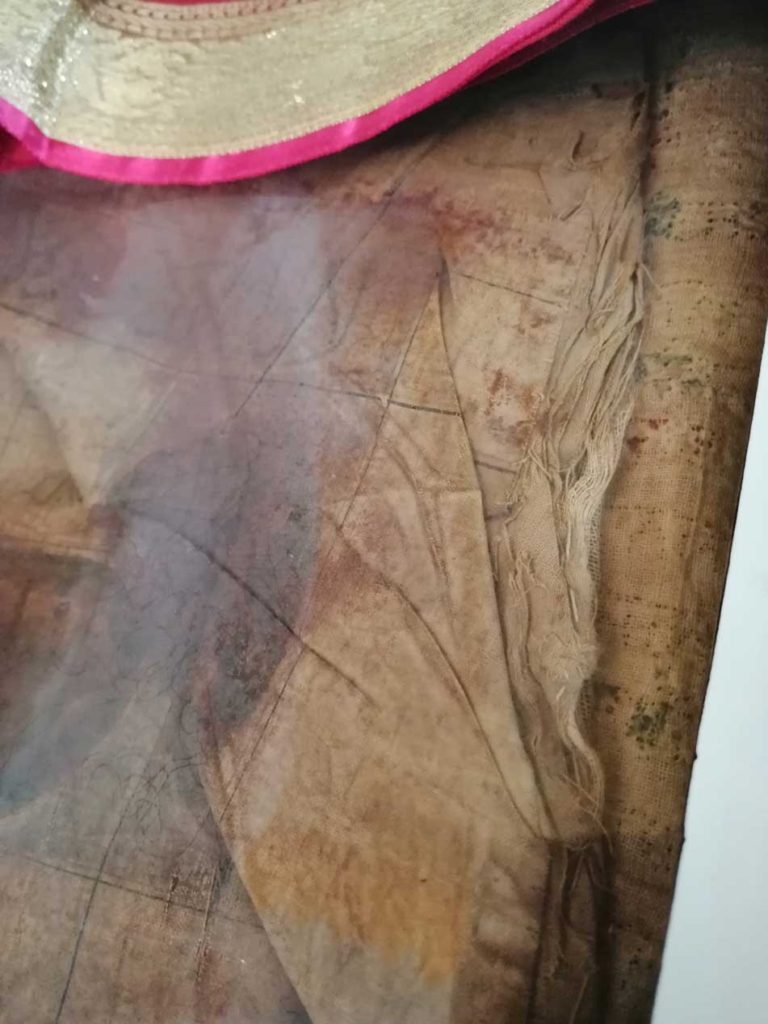
Two kos (a measure of distance) away from the city, Guru Sahib sat down wearing the Khilka for 7 days. Some people say that 30 verses of the Quran could be seen on the Khilka. They went and told the King, ‘this is Godlike, unlike human beings.’
Baba Nanak’s visit is also mentioned in the Vars of Bhai Gurdas.3 It is a belief that Kaaba circumambulated around Baba Nanak in Mecca. Everyone was amazed to see this power of Guru Ji. The details of these events are preserved in Arabic manuscripts like Shayato Baba Nanak Faqir and Twarik-e-Arab. Punjabi literature also testifies Arabic Kaaba Feria.5 The Chief Imams of the four sects of Islam, such as Imam Zafar, Imam Safi, Imam Kamaldin and Imam Jamal Din, and the King bowed to Guru’s power. There they pronounced Nanak, the last prophet of Medina as a manifestation.6
It is my belief that the Khilka -Chola that Guru Sahib received in Mecca as an honour, might have been given by all of them when Nanak was pronounced the last prophet in Medina. After their request, Guru Ji bestowed a pair of sandals7, a needle, an Assa (stick), a handwritten Gutka (small book of prayers) of Japji Sahib in Arabic and more.
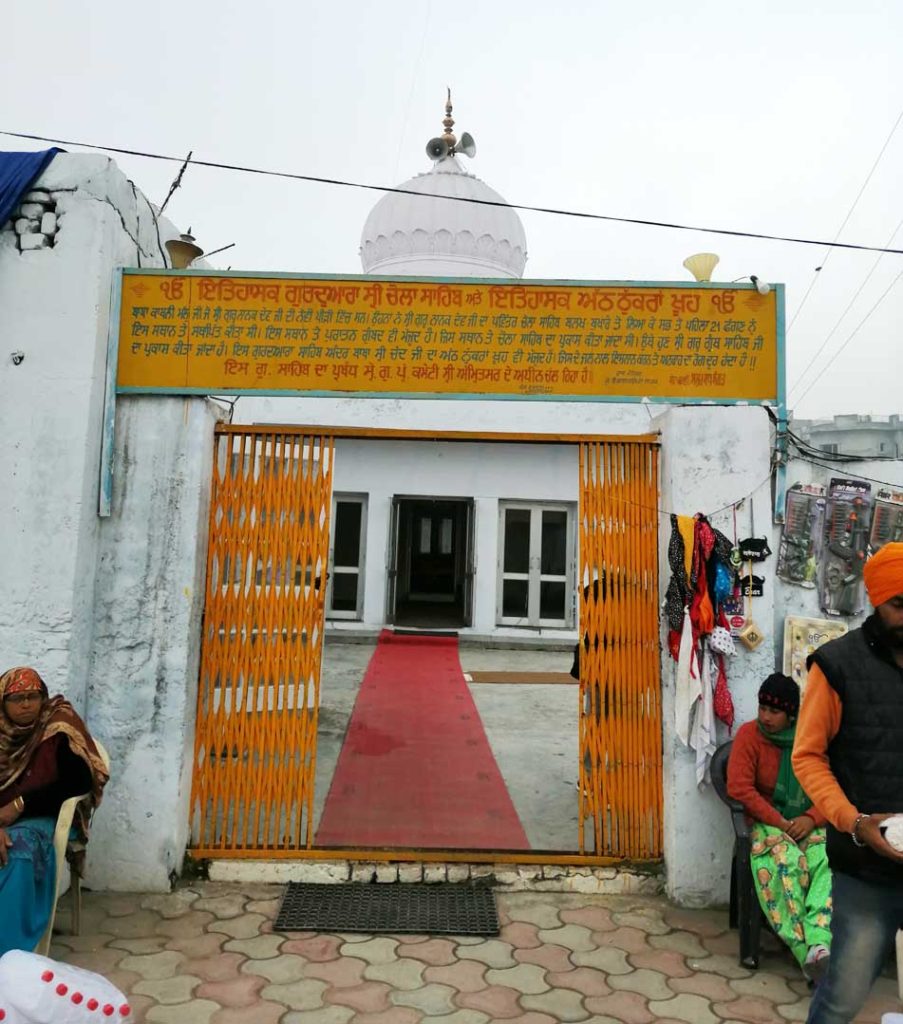
It is recorded in Arabic writings that when Guru Ji prepared to go to Medina from Mecca, everyone expressed great shock. Baba Ji said that Khudavand Kream (Almighty God) has ordered him, just go there for enforcement of his order. On the silk robe that was presented to Baba Nanak, some verses of the Quran Sharif and words in praise of Allah are seen.8
After Medina, Guru Ji reached Baghdad via the small route of Faiz. In Baghdad, the world’s largest Islamic World University namely Darul Elim Nizamia9 was running in very high spirits. Guru Nanak Sahib and Bhai Mardana went outside to the cemetery. The Guru began to sing in a melodious and loud voice. When enough people gathered, Guru Ji loudly took Aazan in the opposite direction to Mecca, putting fingers in both ears.
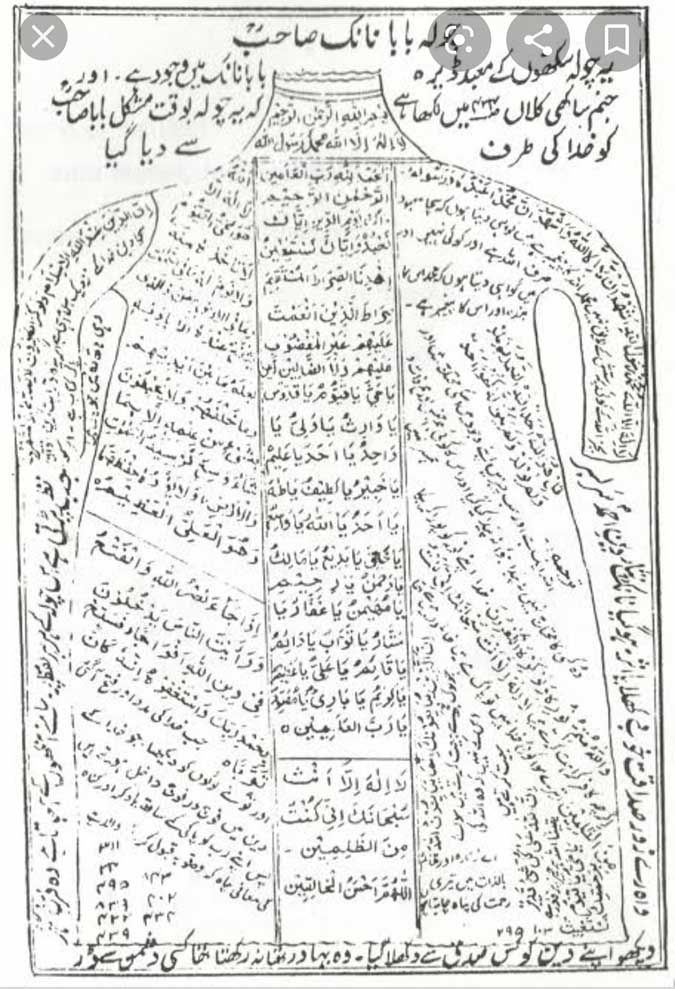
“Allah Hu Akbar Asduhan La Ilah Illa;
Hi Allah Alfalah, Hal Salwah Khairun Minolanome.”
(Sense: God is the greatest. I plead that no more without a God. Let us come for prayers. Prayer is better than sleep.)
There was such an attraction in this Aazan that there was pin-drop silence.10 In Baghdad, Guru Ji had a discussion with Makhdoom at the tomb of Sheikh Abdul Qadir Jilani Dastgeer (1077-1168 AD). Makhdoom was also known as Pir Dastgeer. Peer was accompanied by his son Alam Fazal. Fakir Bahlol is sometimes called by the thoughtful Pir Bahlol Dana’s Sujada Nisheen. This is also mentioned by Bhai Gurdas Ji.11 The spot where the Guru had a discussion with Pir Dasatageer, a historic platform12 still exists. This inscription is in a mixed language of Arabic, Persian and Turkish.

An inscription at Gurdwara Baghdad to commemorate Guru Nanak’s visit there
The small Gurdwara building here is managed by the descendants of Bahlol Ji’s disciple Amar Raza. They also have a holy book13 which contains the text of Japji Sahib and a few words as well as the dialogues of Guru Ji in Mecca and Baghdad. Also, in Baghdad, when Islamic Scholars told Guru Nanak, how he coined the name of Muhammad through Elamey Abajad. Guru Ji replied:
“Naam lo kis ehindse ka, kar lo chu gunna
Do aur mela lo, fer kar lo panch gunna
Bees se urha lo, baki kar lo panch gunna
Iss me do aur bhe lo mella
Nanak Iss bedi nam Muhammad lo bana
Miane lo lokmuma chatpat samja ja”14
“Other variants of this Couplet15 are also popular.
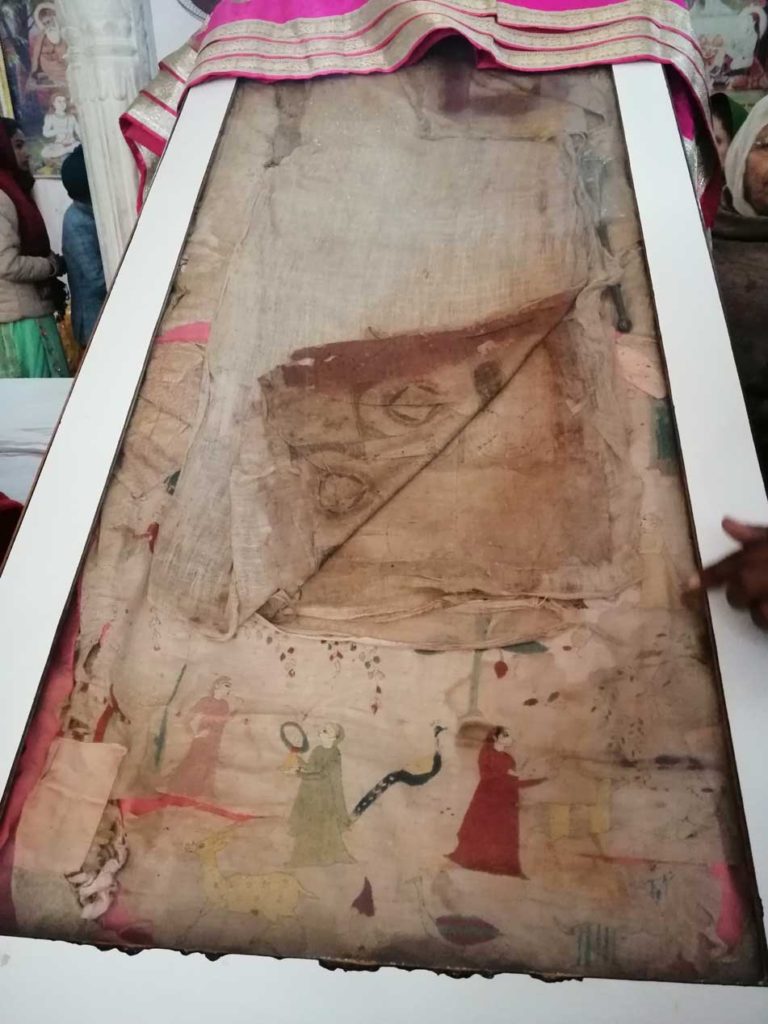
When we see number of Elime Abajad Meem has 40, Ha 8, Meem 40 and Daal 4, thus the 92 forms the name of Muhammad.
The author of Twarikh Guru Khalsa16 is of the opinion that this robe was presented to the Guru by the Begum of Khalifa Bakr, the King of Baghdad.
Yak araza guftum pesh tu dargosah Kuhn kartar.
These words were uttered by Guru Ji in Mecca and Medina, as testified by Arabian manuscripts.
The Mahankosh17 has also mentioned this Chola to Satguru by a lover from Arabia, Persia or Egypt and the Guru who knows all the languages like Sanskrit, Arabic etc. had accepted the Chola respecting the sentiments of well-wishers.
It is recorded in Sikh sources that Guru Nanak took off this robe at Kartarpur and presented it to Guru Angad. This robe has been given to the five Gurus while bestowing Guruship. This robe was kept by Guru Arjan Dev Ji while serving at the Sarovar in Amritsar. Guru Arjan Sahib presented this Chola to Bhai Tota Ram, a Sikh from Balkhbukhara. This robe remained with his family for many centuries.
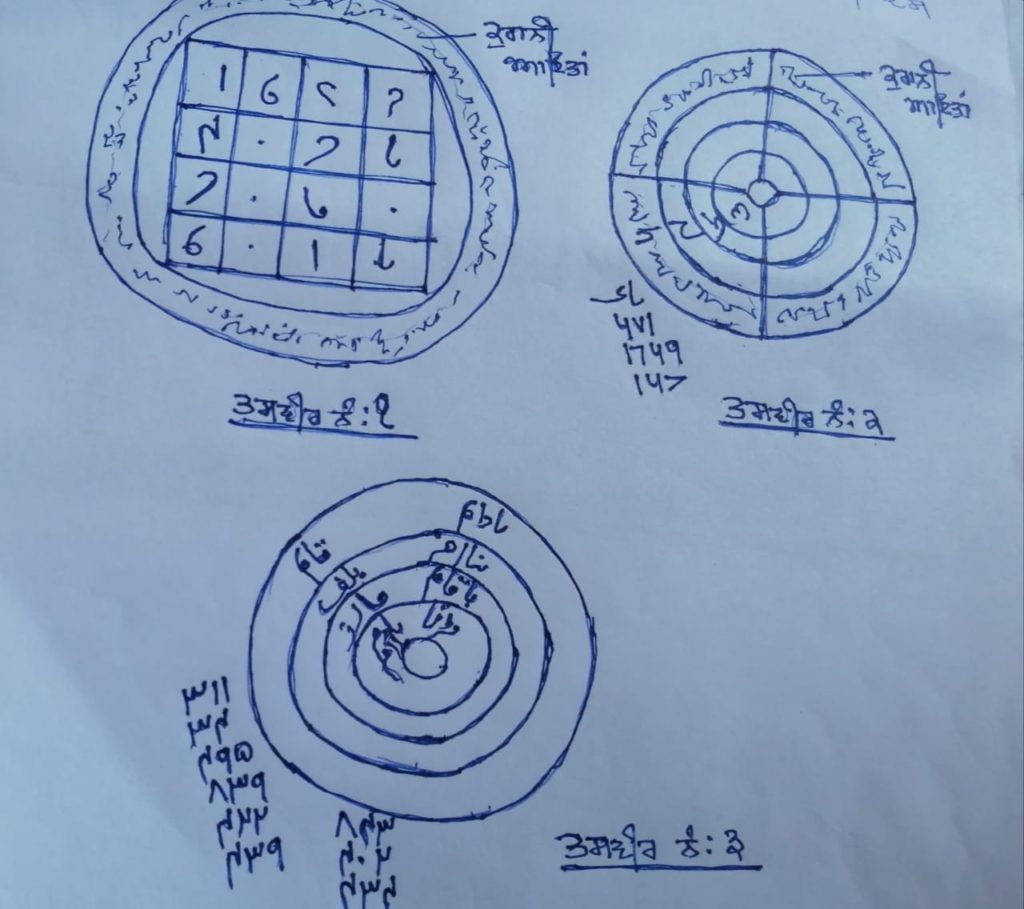
Rings with Messages as displayed on the Khilka -robe of honour,
presented to Guru Nanak Sahib
In the ninth generation of Guru Nanak, Kabli Mall Ji brought the Chola to Dera Baba Nanak in Gurdaspur. This Chola was established by building a Gurdwara. This Chola was placed here on 20 Fagun 1884 Bikrami (1 March 1828 AD) and every year on 21-23 Fagun, the devotees have a glance of the Chola. There was also langar introduced at that time and over a period of time became famous as ‘Gurdwara Langar Chola Sahib.’ During the Akali movement (1920-25) when Gurdwara Darbar Sahib came under Panthic management, the Shiromani Gurdwara Parbandhak Committee placed the site under its management and the right to keep Chola Sahib was given to the Guru’s descendants.
I have taken close-up photos of the Chola preserved in a glass box. Unfortunately, my desire to touch and see the whole Chola was denied by the custodian. The Arabic verses and round circles are drawn, in which numerals of all languages are written. An embroidered handkerchief under the Chola said to be of Bebe Nanaki -sister of Guru Nanak Sahib and Chaur Sahib -the ceremonial fan made of animal hair or synthetic material of Guru Arjan Sahib were also seen by me.
It is said that when Sikh general Hari Singh Nalva visited Chola Sahib, he presented two precious Romallas -ceremonial coverings for Guru Granth Sahib; which are adorned in another glass box. Fifty meters away from the main Gurdwara Sahib, where the Bedi family resides, there is Parkash of Guru Granth Sahib in a room alongside the Cholla Sahib. In the same complex is the Samadhi of Baba Kabli Mal and an octagonal well.
“ਲਾਹਿ ਲਾਇਆ ਅਲਾਹ ਸੁਬਹਾਨ ਕਾਆਨੀਕੁਨ ਤੋ ਮਿਨ ਅਜ਼ ਜ਼ਾਲਮੀਨ”
This Arabic Chola has a unique sign,
“ਲਾਹਿ ਲਾਇਆ ਅਲਾਹ ਸੁਬਹਾਨ ਕਾਆਨੀਕੁਨ ਤੋ ਮਿਨ ਅਜ਼ ਜ਼ਾਲਮੀਨ”
(ਭਾਵ: ਪੂਜਣਯੋਗ ਪ੍ਰਮਾਤਮਾ ਹੀ ਕੇਵਲ ਹੈ। ਮੇਰੇ ਵਰਗੇ ਜ਼ਾਲਮ ਤੇ ਬਖਸ਼ਿਸ਼ ਤੇ ਮਿਹਰ ਕਰਨ ਵਾਲਾ) ਲਿਖਿਆ ਹੈ।
It is made of cotton which is khaki in colour and has some colour on the edges. There are some verses of the Quran written on it. Many names of Allah are also written. Inside this Chola are many round-shaped circles in which numbers of many languages are written.
In the pictures, numerals are seen in Sanskrit, Arabic, Persian and Urdu. The holy names of Allah are written in circles and many digits are found outside the circle. Quranic verses are seen on the outer circles as shown in sketches.
The pen painting of this Arabic Chola was made by Hazrat Mirza Ghulam Ahmad Qadian (1835-1908) or one of his confidants -Ghulam Ahmad. He saw this Chola and wrote a long poem18 in Urdu. This book contains Urdu and Persian poems of Qadian Sahib and has been edited by Mehraj-u-Din. Mirza also wrote his few verses around this pen image. Such as,
- ਕਹਾਂ ਹੇਂ ਜੋ ਬਰਤੇ ਹੇਂ ਉਲਫ਼ਤ ਕਾ ਦੰਮ
ਇਤਾਅਤ ਸੀ ਸ੍ਰ ਕੋ ਬਨਾ ਕਰ ਕਦਮ(ਚੋਲੇ ਦੇ ਉਪਰ)
- ਦੇਖੋ ਅਪਣੇ ਦੀਨ ਕੋ ਕਿਸ ਸਿਦਕ ਸੇ ਵੋਹ ਦਿਖਲਾ ਗਿਆ
ਵੋਹ ਬਹਾਦੁਰ ਥਾ ਰਖੱਤਾ ਥਾ ਕਿਸੇ ਦੁਸ਼ਮਣ ਸੇ ਡਰ(ਹੇਠਾਂ)
- ਦੋਰੇ ਜ਼ੋਰੇ ਸਦਾਕਤ ਖੂਬ ਦਿਖਾਇਆ ਅਸ਼ਰ
ਹੋ ਗਿਆ ਨਾਨਕ ਦੀਨ ਮੁਹੰਮਦ ਸਰਬਸਰ (ਸਜੇ ਪਾਸੇ)
- ਜਬ ਨਜ਼ਰ ਪੜਤੀ ਹੈ ਉਸ ਚੋਲੇ ਕੇ ਹਰ ਹਰ ਲਫ਼ਜ ਪਰ
ਸਹਾਮਨੇ ਆਖੋਂ ਕੇ ਆ ਜਾਤਾ ਹੈ ਵੋਹ ਗੁਣੀਗਹਿਰ(ਖਬੇ ਹੱਥ)
Mirza Ghulam Ahmad’s remarkable poem19 is seventeen pages long.
It is conclusively clear that Guru Nanak’s Arabic Chola is in Dera Baba Nanak-a testimony to Guru Sahib’s successful visits to Mecca, Medina and Baghdad.
References and Notes:
- Guru Nanak did four tours in 22 years, about 25 thousand miles journey. First south (1497-1508 AD.), Second east (1510-1515 AD.), Third Uttarakhand (1516 – 1518 AD.), And the fourth to the west (1518-1522 AD.)
- The copy of this book was copied from Khadoor Sahib Pothi and printed from Albad Diwan Buta Singh Malik Matbai Aftab Punjab, Lahore. Below it has the signature of Bhai Tara Singh of Amritsar.
- “ਫਿਰਿ ਮਕੇ ਆਇਆ ਨੀਲ ਬਸਤ੍ਰ ਧਾਰੇ ਬਨਵਾਰੀ
ਆਸਾ ਹਥਿ ਕਿਤਾਬ ਕਛਿ ਦੂਜਾ ਬਾਂਗ ਮੁਸਲਾ ਧਾਰੀ” - Jasbir Singh Sarna -Guru Nanak’s Journey to Arab Countries, Jammu and Kashmir, 2019, page 16.
- Bhai Santokh Singh ^ Sri Nanak Prakash, Chapter – 58
- Ibid,
- Ibid,
- Guru Nanak Sahib’s Journey to Arab countries, 24-25
- The University was opened by Nizam kutsey 459 Hijri (1203 AD). Muslims from the globe came here to educate. This was considered a stronghold of Muslim Scholars.
- Bhai Gurdas, 1: 35
- Ibid, 2:36
- This platform was first seen by Sikh military officers. Then in 1918 AD Dr Kirpal Singh reported the inscription in a letter to his brother Seva Ram Singh. This was mentioned by Swami Anand Acharya in his book The Snow Birds, 1919 page 182. Swami had only seen the faded inscription and written date 912 Hijra where the actual date is 927 Hijra.
- ਗੁਰੂ ਨਾਨਕ ਸਾਹਿਬ ਦਾ ਅਰਬ ਦੇਸ਼ਾਂ ਦਾ ਸਫਰਨਾਮਾ, ਉਹੀ, ਅੰਕ: 48
- These verses were written to me 40 years ago by Molvi Bande of Hazrat Bal, Srinagar (Kashmir). He had said that these verses were coming to us after hearing from the Muslims of Arabia and Syria. Other forms of these lines are also prevalent in Muslim countries.
- Examples are as follows :
(1) Muhammad four letters. Total 92 (2) Raab. four letters. Total of 92
16. Giani Gian Singh, Twarikh Guru Khalsa, Part 2, Department of Languages, Punjab, Patiala, Print 2011, Issue: 269 – 270 “In Baghdad, Khalifa Bakkar, the son of Khalifa Wahid, caused great sorrow to the people and the fakirs. Many saints were imprisoned for witnessing miracles. Khalifa Bakkar also came to pay homage to Guru Ji after hearing his praises, then Baba Ji uttered the words :
“ਨਾਨਕ ਆਖੇ ਰੇ ਮਨਾ ਸੁਣੀਐ ਸਿਖ ਸਹੀ
……. …….. ……….. ………….
ਕੂੜ ਨਿਖੁਟੇ ਨਾਨਕਾ ਓੜਕ ਸਚ ਰਹੀ।
Hearing these words, the Caliph folded his hands in front of Baba and said, “Tell me some service.” Baba Ji said the miracle is hurting the fakirs, your intention is for a son, so God will fulfil.
17. Bhai Kahn Singh Nabha – Gurshabad Ratnakar Mahan Kosh, Part 2, page 357
18. Mehraj – u-Din Darre samine, Urdu, August 1906, Lahore Islamia Steam Press, pages: 38 – 54
19. Ibid: 38,48,49, 50,52,53,54
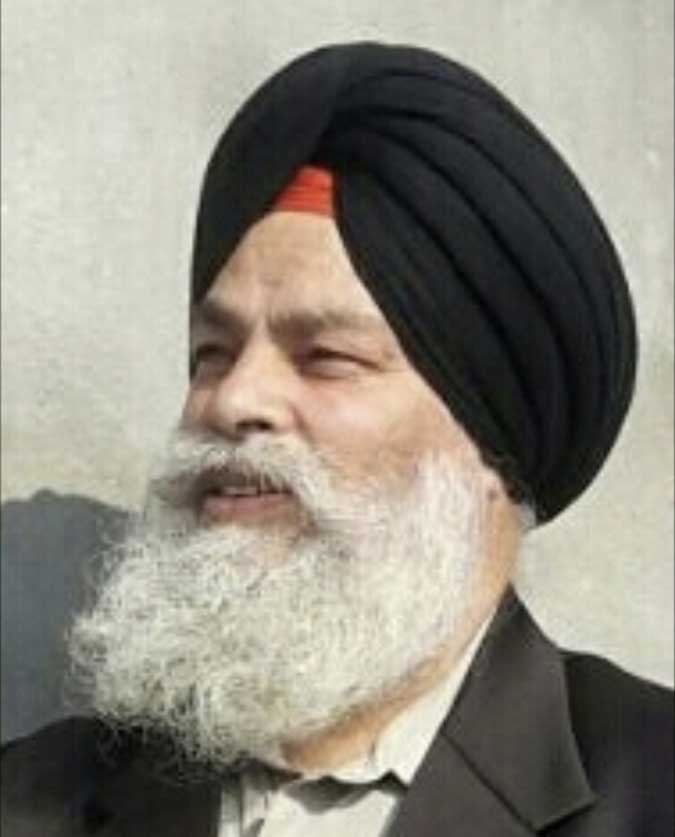 Jasbir Singh Sarna is a voracious writer in Punjabi, English and Urdu. Hailing from Jammu, he has participated in many Panthic activities during his student days. He was the founder-editor of Shamsheer-e-Dast magazine of the All India Sikh Students Federation. He has visited Pakistan chronicling the travels of Guru Nanak. He has been honoured by many institutions across the world.
Jasbir Singh Sarna is a voracious writer in Punjabi, English and Urdu. Hailing from Jammu, he has participated in many Panthic activities during his student days. He was the founder-editor of Shamsheer-e-Dast magazine of the All India Sikh Students Federation. He has visited Pakistan chronicling the travels of Guru Nanak. He has been honoured by many institutions across the world.
 Print
Print

 177
177


One thought on “Muslim savants fascinated with Guru Nanak’s spirituality, gift the Arabic robe”